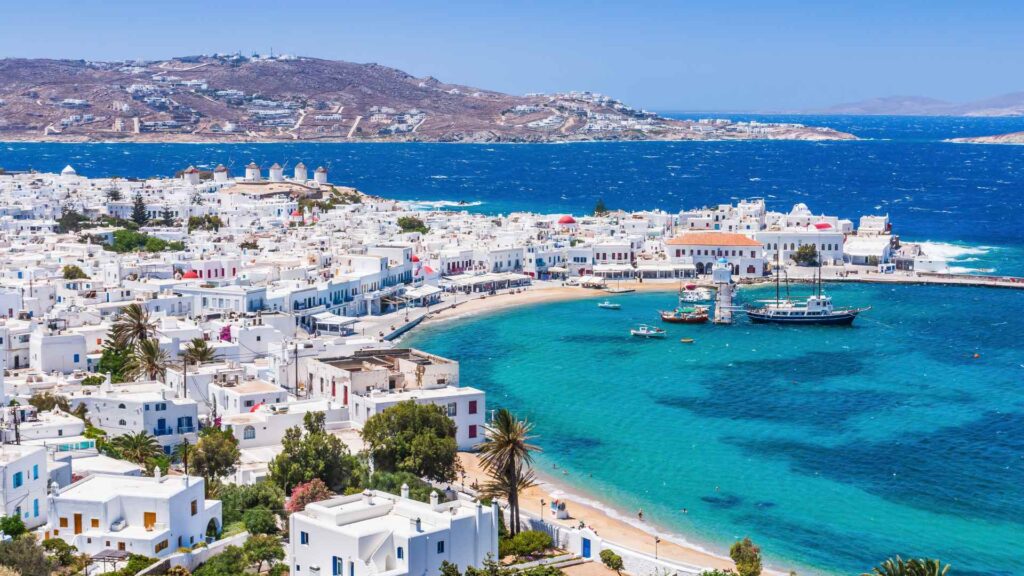Greece, with its sun-soaked islands, turquoise waters, and ancient history, offers a cruising experience like no other.
From iconic archaeological sites to picturesque villages, each port is a gateway to adventure. Greek cruises provide an ideal mix of relaxation, cultural exploration, and stunning scenery.
Highlights of a Greek Cruise:
- Visit UNESCO World Heritage Sites like the Acropolis or Delos.
- Explore islands like Santorini and Mykonos, each with unique charm.
- Experience delicious Mediterranean cuisine and vibrant nightlife.
Greek cruises cater to every traveler, from history buffs to beach lovers, offering a perfect balance of leisure and discovery.

When to Cruise the Greek Isles
The timing of your cruise can significantly affect your experience. Greece boasts pleasant weather nearly year-round, but each season offers distinct advantages.
Best Months to Cruise:
- Spring (April–June): Blooming flowers, mild temperatures, and fewer crowds.
- Summer (July–August): Perfect for beach days but expect higher prices and busier ports.
- Fall (September–October): Warm waters, lower prices, and quieter destinations.
For a seamless trip, consider the off-peak months of May and September, when you can enjoy mild weather and fewer tourists.
Essential Tips for Cruising Greek Ports
Maximize your experience by planning wisely. Greek cruise ports are diverse, each offering unique attractions and experiences. With the right preparation, you can make the most of your time at each stop, ensuring a smooth and memorable adventure.
Packing Essentials
Packing strategically for your Greek cruise can make your trip more comfortable and enjoyable.
- Lightweight, breathable clothing: Greece’s warm Mediterranean climate makes light fabrics like cotton and linen ideal. Pack layers for cooler evenings, especially in spring or fall.
- Comfortable walking shoes: Many Greek ports have cobblestone streets, steep inclines, and uneven paths. Opt for sturdy sandals or sneakers designed for walking.
- Hat and sunscreen: The Greek sun can be intense, particularly in summer. A wide-brimmed hat and high-SPF sunscreen are must-haves to protect your skin.
- Reusable water bottle: Stay hydrated throughout the day. Many Greek islands have free public water refill stations, so a reusable bottle helps reduce plastic waste.
- Waterproof bag or pouch: For beach excursions, a waterproof bag can protect your electronics and valuables.
Local Currency
Navigating financial transactions is straightforward in Greece, but it’s wise to be prepared.
- The Euro (€): This is the official currency, and it’s accepted everywhere, from cafes to souvenir shops.
- Small denominations: Many small businesses, especially on the islands, prefer cash transactions. Carrying €5, €10, and €20 notes will make paying for small items or tips easier.
- ATMs: Most major ports have ATMs, but there may be queues during busy cruise days. Withdraw cash ahead of time to avoid waiting.
- Credit cards: These are widely accepted in urban centers like Athens and popular islands like Santorini. However, smaller, family-run establishments may prefer cash.
Excursions
Planning your excursions thoughtfully is key to fully enjoying your time at each port.
- Book early: Popular attractions like the Acropolis or Santorini’s Oia Village can sell out quickly during peak season. Reserve your excursions as soon as you book your cruise.
- Independent tours: While cruise-line excursions offer convenience, local tour operators often provide smaller group sizes and more personalized experiences. These can also be more cost-effective.
- Self-guided exploration: For seasoned travelers, exploring on your own can be rewarding. Research maps and key sights in advance. Apps like Google Maps or offline guides like Maps.me can help you navigate unfamiliar areas.
- Time management: Ensure you return to your ship on time. Ships wait for cruise-line-organized tours but may not delay for independent travelers. Plan to return at least 1–2 hours before departure.
- Mix activities: Balance sightseeing with leisure. Spend your morning exploring a historic site, and reserve your afternoon for a relaxing beach or local café visit.
Connectivity and Communication
Staying connected can enhance your trip and keep you organized.
- Wi-Fi availability: Many ports offer free Wi-Fi in cafes or public areas. Some cruise ships also provide packages for internet access.
- Local SIM cards: If you plan to stay in Greece before or after your cruise, a local SIM card may offer affordable data options.
- Language basics: Although English is widely spoken, learning a few Greek phrases like “kalimera” (good morning) or “efharisto” (thank you) can enhance your interactions with locals.
Be Mindful of Greek Customs and Etiquette
Respecting local culture can make your trip smoother and more enjoyable.
- Tipping: It’s customary to leave a small tip at restaurants (5–10%), cafes, and for tour guides. A few coins are appreciated for taxi drivers or hotel staff.
- Dress modestly for churches: If visiting religious sites, wear clothing that covers your shoulders and knees. Bring a lightweight scarf for this purpose.
- Be polite: Greeks are known for their warm hospitality. A friendly smile and a greeting go a long way in building rapport.
With these tips, you’ll be well-prepared to make the most of your Greek cruise adventure, ensuring a hassle-free and enriching experience at every port.

Piraeus (Athens): Gateway to Ancient Greece
The port of Piraeus serves as the primary entry point to Athens, one of the most historically rich cities in the world.
Top Attractions:
- The Acropolis: A must-see, featuring iconic landmarks like the Parthenon and Erechtheion.
- Plaka District: Wander through charming streets filled with tavernas and shops.
- National Archaeological Museum: Dive into Greece’s ancient history with its impressive collection.
Tips for Visiting Athens from Piraeus:
- Use the metro for a quick and budget-friendly ride to central Athens.
- Allocate at least half a day to explore the Acropolis fully.
Santorini: Iconic Beauty of the Cyclades
Santorini is a postcard-perfect island known for its white-washed buildings, blue-domed churches, and breathtaking sunsets.
Must-See Attractions:
- Oia Village: Renowned for its sunset views and boutique shops.
- Fira: The island’s bustling capital, accessible by cable car from the port.
- Akrotiri Archaeological Site: An ancient Minoan city preserved in volcanic ash.
Local Experiences:
- Savor a glass of Assyrtiko wine at a local winery.
- Relax at the black sand beaches of Kamari or Perissa.
Mykonos: Cosmopolitan Charm Meets Tradition
Known for its vibrant nightlife and stunning beaches, Mykonos also offers a rich cultural heritage.
Top Spots to Explore:
- Little Venice: A picturesque area with waterside cafes and bars.
- Windmills of Mykonos: Iconic landmarks offering panoramic views.
- Delos Island: A short ferry ride away, this UNESCO site is steeped in mythology and history.
Pro Tip: Visit Mykonos early in the day to avoid the crowds and enjoy a quieter, more authentic experience.
Rhodes: The Island of Knights
Rhodes is a mix of medieval history and sun-drenched beaches, making it a favorite among cruisers.
Historical Highlights:
- Rhodes Old Town: A UNESCO World Heritage Site with medieval walls, cobbled streets, and the Palace of the Grand Master.
- Acropolis of Lindos: A stunning archaeological site with panoramic sea views.
Beaches to Visit:
- Faliraki Beach for water sports and family fun.
- Anthony Quinn Bay for secluded swimming and snorkeling.

Corfu: A Jewel in the Ionian Sea
Corfu combines Venetian, French, and British influences, creating a unique atmosphere.
Notable Attractions:
- Corfu Town: Explore Spianada Square, the Old Fortress, and Liston promenade.
- Achilleion Palace: The former summer retreat of Empress Elisabeth of Austria.
- Paleokastritsa: Known for its stunning bays and crystal-clear waters.
Insider Tip: Try the local delicacy, pastitsada (a rich pasta dish), at a traditional Corfiot taverna.
Crete: Land of Myth and Majesty
Crete, Greece’s largest island, offers a wealth of history and natural beauty.
Best Things to Do:
- Knossos Palace: Discover the myths of the Minotaur and labyrinth at this Minoan archaeological site.
- Heraklion Archaeological Museum: A treasure trove of artifacts from ancient Crete.
- Elafonissi Beach: Famous for its pink sand and turquoise waters.
Crete also boasts incredible hiking trails, including the Samaria Gorge for adventurous travelers.
Kusadasi (for Ephesus): A Step Beyond Greece
While technically in Turkey, Kusadasi is a popular stop on Greek cruises due to its proximity to the ancient city of Ephesus.
Top Highlights in Ephesus:
- Library of Celsus: A stunning remnant of Roman architecture.
- The Great Theater: An enormous amphitheater that once hosted gladiatorial games.
Shopping and Dining:
Kusadasi’s bazaars are great for picking up Turkish rugs, spices, and jewelry. Don’t miss trying authentic Turkish delights.
Thessaloniki: Greece’s Cultural Capital
Thessaloniki blends history with a modern, vibrant city atmosphere.
Places to Explore:
- White Tower: A symbol of the city and home to a fascinating museum.
- Rotunda: An ancient Roman structure with stunning mosaics.
- Aristotelous Square: The city’s lively heart, perfect for people-watching.
Cuisine Highlights:
Enjoy Thessaloniki’s culinary specialties, including bougatsa (a creamy pastry) and gyros.
Patmos: The Sacred Island
Known as the “Jerusalem of the Aegean,” Patmos is a peaceful and spiritual destination.
Religious Sites:
- Monastery of St. John: A striking fortress-monastery dominating the island.
- Cave of the Apocalypse: Believed to be where St. John received his visions.
Patmos is also ideal for serene beaches and quiet cafes, offering a break from bustling tourist hubs.
Nafplio: The First Capital of Modern Greece
Often overlooked, Nafplio is a charming port city with Venetian and Ottoman influences.
Don’t Miss:
- Palamidi Fortress: Accessible by climbing 999 steps for panoramic views.
- Bourtzi Castle: Located on a small island, offering a unique day trip.
- Arvanitia Promenade: A scenic coastal walk perfect for unwinding.
Hydra: A Car-Free Paradise
Hydra’s unique charm lies in its ban on vehicles, offering an unspoiled and tranquil environment.
Top Activities:
- Explore Hydra Town: Narrow streets lined with boutique shops and cafes.
- Hiking Trails: Paths lead to stunning viewpoints and hidden beaches.
Hydra’s quiet atmosphere makes it ideal for a relaxing day exploring by foot or donkey.
Tips for Enjoying Greek Cuisine at Port Stops
Greek cuisine is a highlight of any cruise, with fresh ingredients and traditional recipes.
Must-Try Dishes:
- Moussaka: A layered eggplant and meat casserole.
- Souvlaki: Grilled meat skewers served with pita and tzatziki.
- Baklava: A sweet pastry made with layers of filo and honey.
Be sure to pair your meals with local wines or ouzo, Greece’s iconic anise-flavored spirit.
FAQs About Greek Cruise Ports
1. Do I need a visa to visit Greece on a cruise?
Most travelers from the EU, US, and Canada do not require a visa for short visits.
2. What currency is used in Greek ports?
The Euro (€) is the official currency. Credit cards are widely accepted, but cash is useful for small purchases.
3. Are English speakers common in Greece?
Yes, English is widely spoken in tourist areas, including ports and major attractions.
4. What’s the best way to get around at Greek ports?
Local buses, taxis, and rented scooters are common. Walking is also ideal in smaller towns.
5. How much time should I spend at each port?
Allocate at least 4–6 hours for smaller islands and a full day for larger cities like Athens or Rhodes.
6. Is tap water safe to drink in Greece?
Tap water is safe in most cities but stick to bottled water on smaller islands.
Conclusion
Greek cruise ports offer an unforgettable blend of history, culture, and natural beauty. Whether exploring ancient ruins in Athens or savoring sunsets in Santorini, every stop is an adventure waiting to happen.
